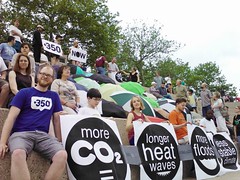 一份經過學者共同審查的研究指出,在本世紀末,美國還會有超過15萬人死於氣候變遷造成的高溫。
一份經過學者共同審查的研究指出,在本世紀末,美國還會有超過15萬人死於氣候變遷造成的高溫。
該研究包含了40個城市,在本世紀末高溫造成死亡人數的前三個城市分別是:肯塔基州的路易斯維爾,19000人;密西根州的底特律,18000人;以及俄亥俄州的克里夫蘭,17000人。
這項研究由邁阿密大學地理與區域研究資深教授Larry Kalkstein所進行,研究所包含的40個城市人口,大約佔全美的2/3。國家自然資源保護委員會(NRDC)23日則將Kalkstein教授的結論作成一份報告,並繪製了一份地圖。
「這類的研究應該在全國各地成為頭條報導,但是發表在學術期刊中通常都被忽略,」NRDC 氣候與清淨空器專案計畫主任Daniel Lashof說道,「所以NRDC將這項資訊已更容易被取得的方式呈現,並加上本世紀中至末期因為全球暖化的可能累計死亡人數。」
這份報告名為《炎夏殺手》(Killer Summer Heat) ,其死亡人數預估值是基於一項假設「越是缺少有效的新政策,碳污染越是嚴重;而到本世紀末,碳污染會是現在的兩倍以上。」
根據上述理論基礎,部份城市在世紀末的預計死亡數為:
- 巴爾的摩:2900人
- 波士頓:5700人
- 芝加哥:6400人
- 哥倫比亞:6000人
- 達拉斯:7000人
- 丹佛:3500人
- 洛杉磯:1200人
- 明尼亞波里斯:7500人
- 費城:700人
- 匹茲堡:1200人
- 聖路易:5600人
- 華盛頓DC:3000人
「這些發現顯示,氣候變遷是在我們身邊攸關生死的明顯事實,」Lashof 博士說道,「隨著碳污染持續的增加,氣候變遷將會增加夏天中危險高溫的天數,造成死亡人數大幅增加。」
 一切都發生的非常快。就在本月中旬,美國國家海洋暨大氣管理局(NOAA)才發表報告,指出4月30日前的12個月月均溫,是美國自1895年開始記錄以來,最熱的12個月。
一切都發生的非常快。就在本月中旬,美國國家海洋暨大氣管理局(NOAA)才發表報告,指出4月30日前的12個月月均溫,是美國自1895年開始記錄以來,最熱的12個月。
Kalkstein 表示,他所提的數據並不包含心臟病與呼吸衰竭,因為醫學上核心體溫必須要高於攝氏40度才會被歸類為高溫死亡。
Kalkstein 並說,溫差高的城市風險比像邁阿密這樣溫差低的城市要更高。
「底特律是研究高溫死亡相關的好地點,」他說,「底特律多數的夏天氣候溫和,但後來我們發現溫度快速上升至攝氏32度。底特律的空調設備較少且貧民較多。」這樣的情況都使得高熱相關的死亡數人數增加。
當國家氣象局發布高溫特報時,城市可以開放空調避難所。可以設立高溫諮詢專線,當民眾感覺到暈眩不適時,可以洽詢處理方式。另外,也可以增加醫院急診室的人手。
Kalkstein 指出,費城對熱浪處理的方式可以做為模範。費城採取了上述所有的措施,也有街區的志工,會挨家挨戶詢問每個人是否無恙,並且在有關當局與居民間負責聯繫。為了進行這些工作,費城每個夏天花費約15萬美金。
Kalkstein 博士也與環保署合作,研究他所研發的高溫健康警告系統(Heat Health Warning Systems)在各種氣候變遷的條件下,能夠拯救多少性命。
Lashof 博士說,解決這些生死攸關問題的辦法,是限制造成高溫問題的溫室氣體由發電廠與其他像是機動車輛等來源的排放。
Lashof 呼籲關心這問題的民眾,參加美國環保署24日於華府與芝加哥所舉辦有關新設電廠碳污染標準提案的公聽會。
美國環保署表示,「新提案的標準只會針對未來興建的電廠,且幫助電力公司透過已採用在興建下一代電廠的現代化科技與步驟,來減少碳污染。」
More than 150,000 additional Americans could die by the end of this century due to excessive heat caused by climate change, finds a new report based on peer-reviewed science.
Of the 40 cities studied, the three with the highest number of projected heat-related deaths through the end of the century are: Louisville, Kentucky with 19,000 deaths, Detroit, Michigan with 18,000 deaths and Cleveland, Ohio with 17,000.
The studies were conducted by Larry Kalkstein, senior professor of geography and regional studies at the University of Miami. They covered 40 cities where about two-thirds of the U.S. population lives.
Dr. Kalkstein's conclusions were publicized Wednesday in a report and map by the Natural Resources Defense Council.
"This is the kind of study that should make headlines around the country but is generally ignored when published only in scholarly journals," said Daniel Lashof, director of NRDC's climate and clean air program. "So NRDC is presenting the information in a more accessible manner, adding calculations of the cumulative additional death toll attributable to projected global warming by mid-century and century's end."
The NRDC report, "Killer Summer Heat," shows projected deaths based on the assumption that carbon pollution will steadily increase in the absence of effective new policies, more than doubling the levels seen today by the end of the century.
On this basis, some of the projected city death tolls by century's end are:
- Baltimore: 2,900 deaths
- Boston: 5,700 deaths
- Chicago: 6,400 deaths
- Columbus: 6,000 deaths
- Dallas: 7,000 deaths
- Denver: 3,500 deaths
- Los Angeles: 1,200 deaths
- Minneapolis: 7,500 deaths
- Philadelphia: 700 deaths
- Pittsburgh: 1,200 deaths
- St. Louis: 5,600 deaths
- Washington, DC: 3,000 deaths
"These findings bring home the fact that global climate change has a number of real life-and-death consequences in our local communities," Dr. Lashof said. "As carbon pollution continues to grow, climate change is only going to increase the number of dangerously hot days each summer, leading to a dramatic increase in the number of lives lost."
Things are heating up quickly now. Last week the National Oceanic and Atmospheric Administration reported that the 12 months that ended on April 30 were the warmest 12 months in the United States since 1895 when recordkeeping began.
Kalkstein said his figures do not include heart attacks and respiratory failure because medical examiners must show a core body temperature of 104 degrees to call it a heat-related death.
Kalkstein says cities with variable temperatures are more at risk than cities with same temperature all the time such as Miami.
"Detroit is a perfect city for heat-related mortalities," he said. "It's comfortable through much of the summers, then we see heat spike up to 90 degrees. There's less air conditioning and a poorer population." These conditions all lead to more heat-related deaths.
Cincinnatians sit beside the Ohio River, making connections between climate change and greenhouse gas emissions as part of the Connect the Dots worldwide climate action event, May 5, 2012 (Photo by 350.org)
They can open air conditioned shelters whenever the National Weather Service calls an excess heat warning. They can set up a heat advice phone line where people feeling dizzy can call to find out what to do. They can increase staff in hospital emergency rooms.
Kalkstein points to Philadelphia as a model of how to cope with heat waves. Philly has taken all these actions and has volunteer block captains who go door to door asking people if they're doing OK, and serving as a contact person between authorities and residents. The city spends approximately $150,000 per summer on these measures, he said.
He is also working with the EPA to determine how many lives can be saved by his developed Heat Health Warning Systems under various climate change scenarios.
Dr. Lashof says the solution to these life and death issues is to limit heat-trapping greenhouse gas emissions from power plants and other sources, such as motor vehicles.
Lashof is urging concerned citizens to attend the U.S. Environmental Protection Agency's public hearings today in Washington, DC and Chicago on the proposed carbon pollution standard for new power plants.
The EPA says, "The proposed standard, which only applies to power plants built in the future, is flexible and would help minimize carbon pollution through the deployment of the same types of modern technologies and steps that power companies are already taking to build the next generation of power plants."







